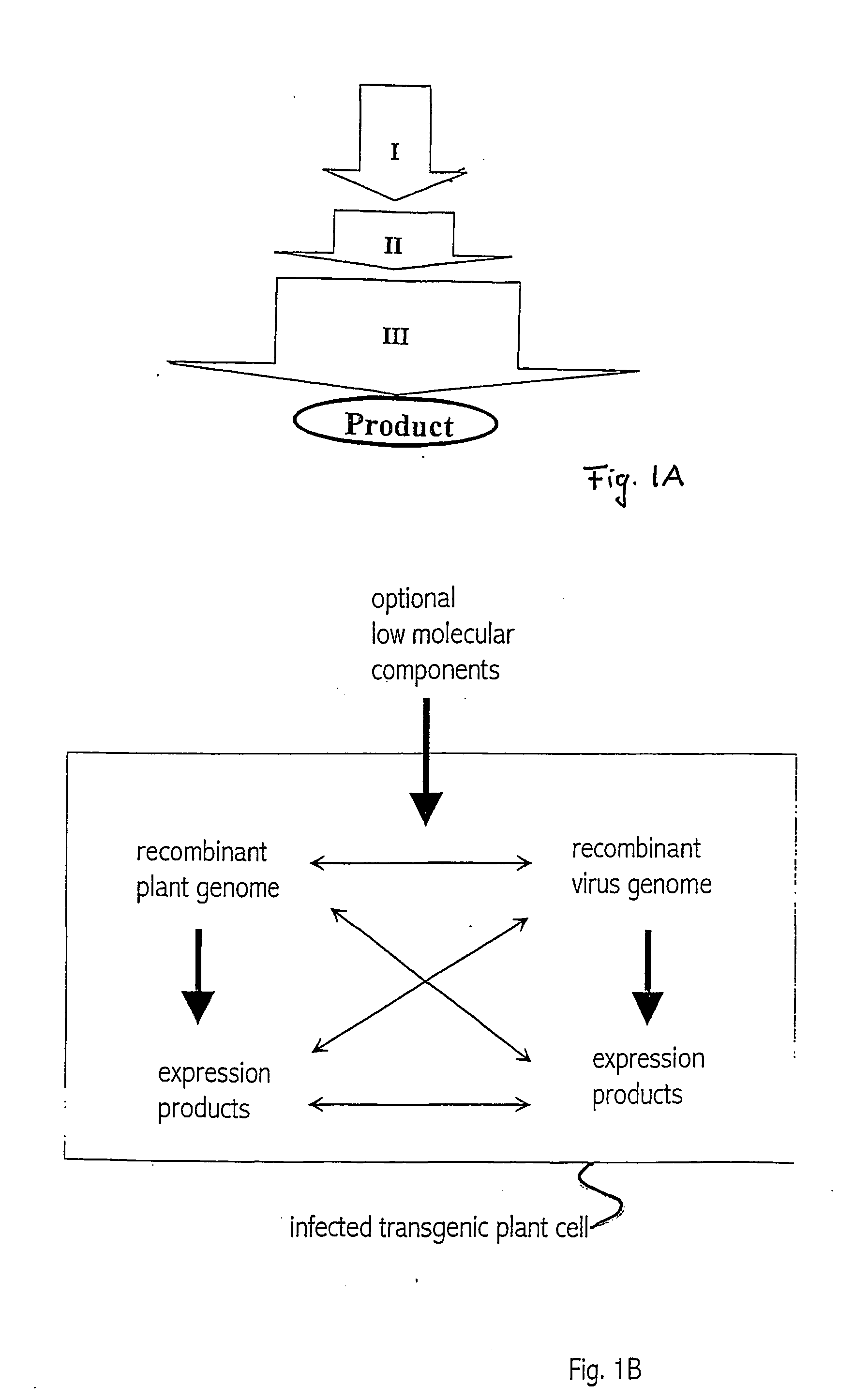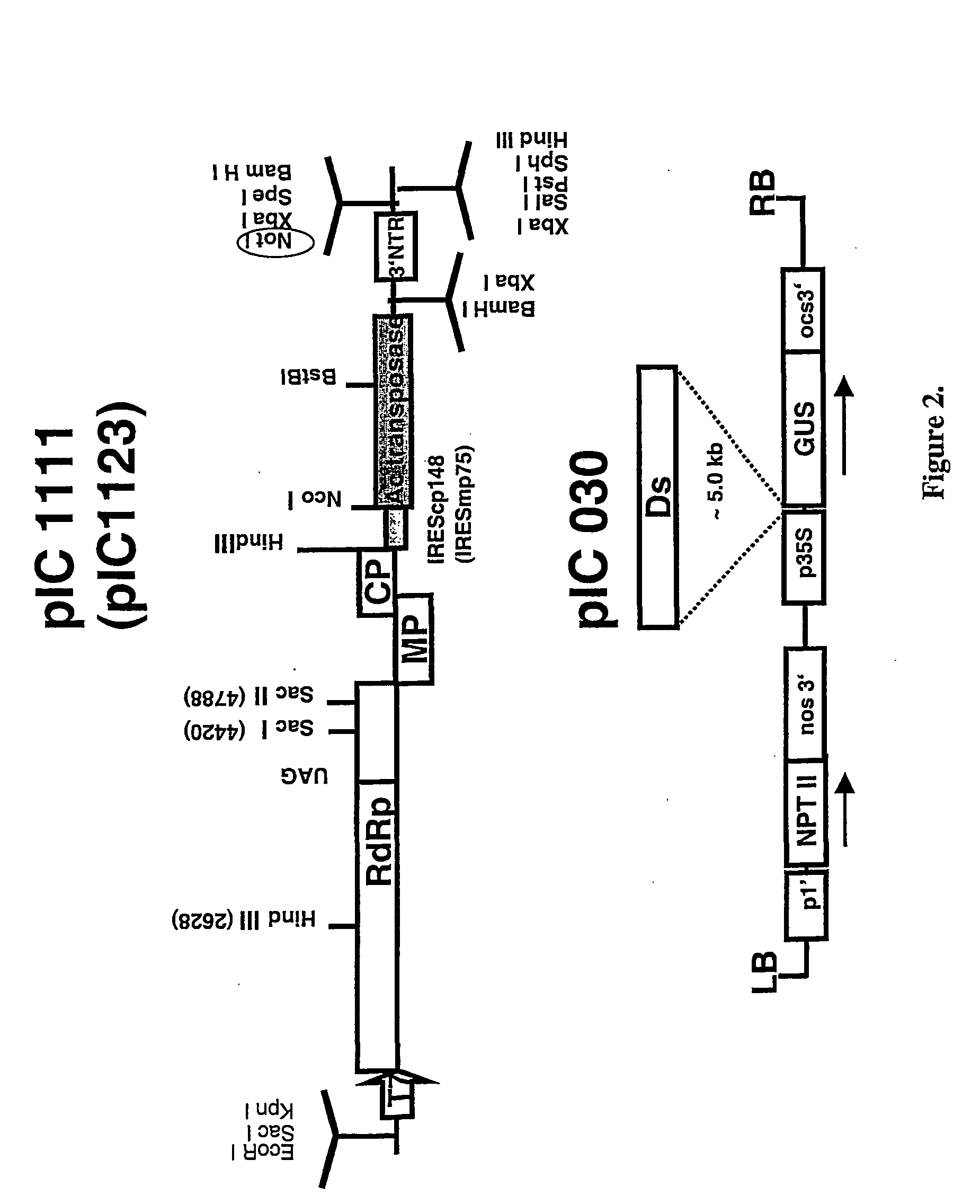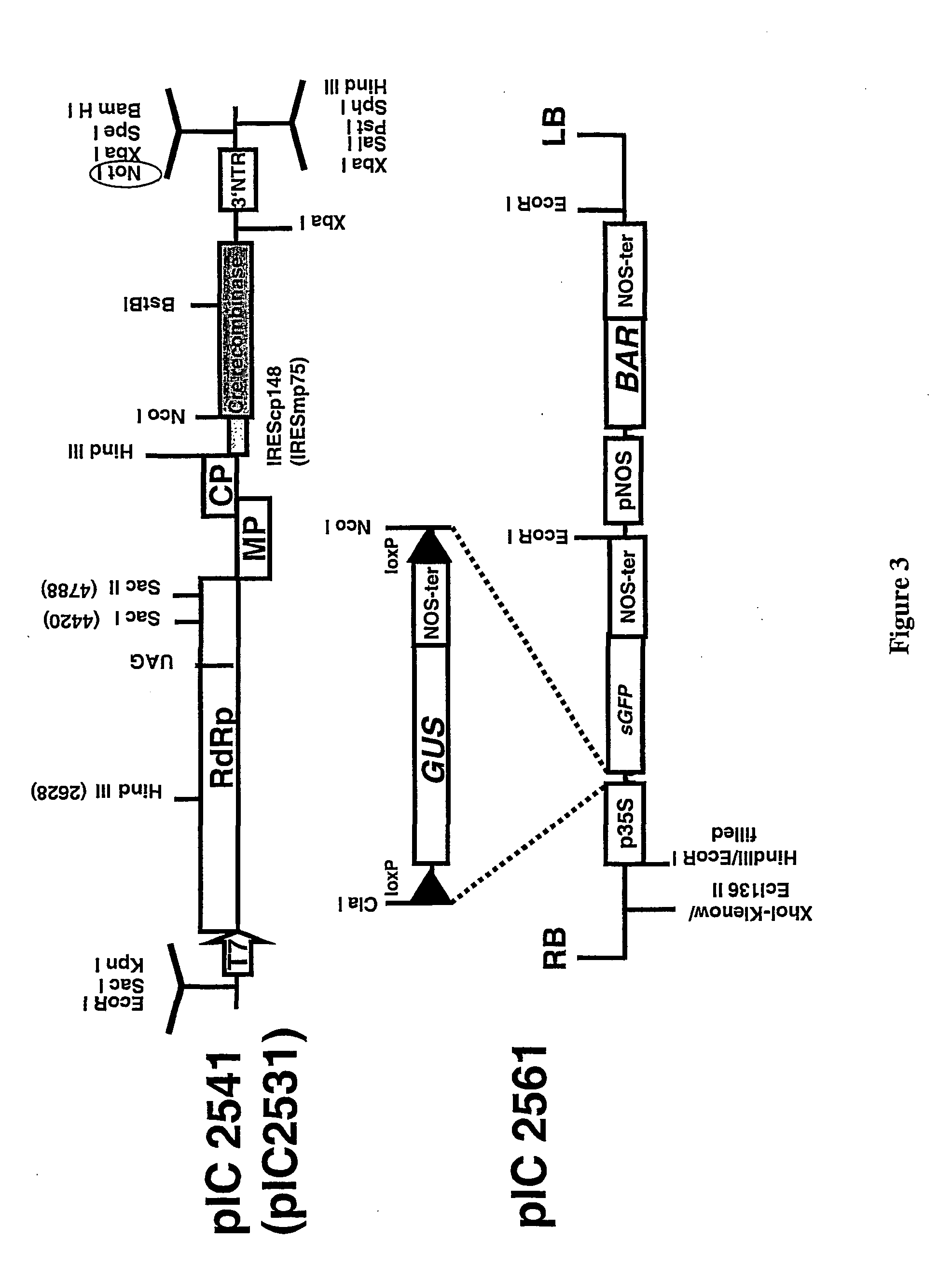Recombinant viral switches for the control of gene expression in plants
a technology plant genes, applied in the field of recombinant viral switches for the control of gene expression in plants, can solve the problems of inability to tight control over expression patterns, inability to achieve large-scale applications, and inability to use antibiotics and steroids as chemical inducers. to achieve stable genome modification, wide versatility and applicability
- Summary
- Abstract
- Description
- Claims
- Application Information
AI Technical Summary
Benefits of technology
Problems solved by technology
Method used
Image
Examples
example 9
Construction of Tobamoviral Vector KS / Act2 / crTMV-Int / IRESMP,75CR-GUS Containing Oleosin Intron from Arabidonsis thaliana
[0335] The main goal of this example is to create vector KS / Act2 / crTMV / IRESMP,75CR-GUS containing Arabidopsis thaliana oleosin gene intron that should be removed after transcript processing (FIG. 31).
[0336] The cloning strategy comprised the following steps: ps 1. Cloning of A. thaliana Oleosin Gene Intron.
[0337]A. thaliana oleosin gene intron was obtained by PCR using A. thaliana genomic DNA and specific primers: A.th. / Int (direct) ATGCTGCAGgttttagttCAGTAAGCACACATTTATCATC (PstI site is underlined, lowercase letters depict crTMV 5′terminal sequence) and A.th / Int (reverse) ATGAGGCCTGGTGCTCTCCCGTTGCGTACCTA (StuI is underlined).
2. Insertion of A. thaliana Oleosin Gene Intron into 334-nt 5′-Terminal Fragment of crTMV cDNA.
[0338] cDNA containing A. thaliana oleosin gene intron was digested with PstI / StuI and ligated with DNA fragment obtained by PCR using primers...
example 10
[0339] Influence of Rapamycin as an Inhibitor of Cap-Dependent Initiation of Translation on GUS Gene Expression in Tobacco Protoplasts transfected with IRESMP,75CR Containing Bicistronic Transcription Vectors, 35S / CP / IRESMP,75CR / GUS (FIG. 32) and 35S / GUS / IRESMP,75CR / CP (FIG. 33)
[0340] The aim of this example is to demonstrate the principal possibility to use inhibitors of cap-dependent translation to increase efficiency of IRES-mediated cap-independent translation of a gene of interest.
[0341] Rapamycin as an inhibitor of cap-dependent initiation of translation was selected. Recently, a novel repressor of cap-mediated translation, termed 4E-BPI (elF-4E binding protein-1) or PHAS-1 was characterized (Lin et al., 1994, Science 266, 653-656; Pause et al., Nature 371, 762-767). 4E-BP1 is a heat- and acid-stable protein and its activity is regulated by phosphorylation (Lin et al., 1994 Science 266, 653-656; Pause et al., Nature 371, 762-767). Interaction of 4EBP1 with elF-4E results in...
example 11
[0343] Influence of Potwirus VPg as a inhibitor of Cap-Dependent Initiation of Translation on GUS Gene in Tobacco Protoplasts Transfected with IRESPM,75CR Containing Bicistronic Transcription Vectors 35S / CP / IRESMP,75CR / GUS (FIG. 32) and 35S / CP-VPg / IRESMP,75CR / GUS
[0344] This example demonstrates the principal possibility of using a gene product to inhibit cap-dependent translation (FIG. 34). Recently, interaction between the viral protein linked to the genome (VPg) of turnip mosaic potyvirus (TuMV) and the eukaryotic translation initiation factor elF(iso)4E of Arabidopsis thaliana has been reported (Wittman et al., 1997, Virology 234, 84-92). Interaction domain of VPg was mapped to a stretch of 35 amino acids and substitution of an aspartic acid residue within this region completely abolished the interaction. The cap structure analogue m7GTP, but not GTP, inhibited VPg-elF(iso)4E complex formation, suggesting that VPg and cellular mRNAs compete for elF(iso)4E binding (Leonard et al....
PUM
| Property | Measurement | Unit |
|---|---|---|
| pH | aaaaa | aaaaa |
| area | aaaaa | aaaaa |
| molecular weight | aaaaa | aaaaa |
Abstract
Description
Claims
Application Information
 Login to View More
Login to View More - R&D
- Intellectual Property
- Life Sciences
- Materials
- Tech Scout
- Unparalleled Data Quality
- Higher Quality Content
- 60% Fewer Hallucinations
Browse by: Latest US Patents, China's latest patents, Technical Efficacy Thesaurus, Application Domain, Technology Topic, Popular Technical Reports.
© 2025 PatSnap. All rights reserved.Legal|Privacy policy|Modern Slavery Act Transparency Statement|Sitemap|About US| Contact US: help@patsnap.com



